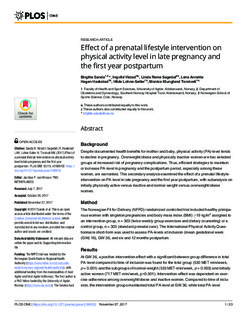| dc.contributor.author | Sanda, Birgitte | |
| dc.contributor.author | Vistad, Ingvild | |
| dc.contributor.author | Sagedal, Linda Reme | |
| dc.contributor.author | Haakstad, Lene Annette Hagen | |
| dc.contributor.author | Lohne-Seiler, Hilde | |
| dc.contributor.author | Torstveit, Monica Klungland | |
| dc.date.accessioned | 2018-05-03T11:22:23Z | |
| dc.date.available | 2018-05-03T11:22:23Z | |
| dc.date.created | 2018-02-02T12:49:03Z | |
| dc.date.issued | 2017 | |
| dc.identifier.citation | PLoS ONE. 2017, 12 (11), . | nb_NO |
| dc.identifier.issn | 1932-6203 | |
| dc.identifier.uri | http://hdl.handle.net/11250/2496974 | |
| dc.description.abstract | Background: Despite documented health benefits for mother and baby, physical activity (PA)-level tends to decline in pregnancy. Overweight/obese and physically inactive women are two selected groups at increased risk of pregnancy complications. Thus, efficient strategies to maintain or increase PA-level in pregnancy and the postpartum period, especially among these women, are warranted. This secondary analysis examined the effect of a prenatal lifestyle-intervention on PA-level in late pregnancy and the first year postpartum, with subanalysis on initially physically active versus inactive and normal-weight versus overweight/obese women. Method: The Norwegian Fit for Delivery (NFFD) randomized controlled trial included healthy primiparous women with singleton pregnancies and body mass index (BMI) ≥19 kg/m2 assigned to an intervention group, n = 303 (twice weekly group-exercises and dietary counseling) or a control group, n = 303 (standard prenatal care). The International Physical Activity Questionnaire short-form was used to assess PA-levels at inclusion (mean gestational week (GW) 16), GW 36, and six and 12 months postpartum. Results: At GW 36, a positive intervention-effect with a significant between-group difference in total PA-level compared to time of inclusion was found for the total group (530 MET-min/week, p = 0.001) and the subgroups of normal-weight (533 MET-min/week, p = 0.003) and initially active women (717 MET-min/week, p<0.001). Intervention-effect was dependent on exercise-adherence among overweight/obese and inactive women. Compared to time of inclusion, the intervention groups maintained total PA-level at GW 36, while total PA-level decreased in the control groups. The PA-levels increased postpartum, but with no significant differences between the randomization groups. Conclusion: The NFFD prenatal combined lifestyle intervention had a significant effect on TPA-level in late pregnancy among women entering pregnancy normal-weight or physically active, thereby preventing the downward trend typically seen during pregnancy. Intervention-effect among overweight/obese and physically inactive women was, however, dependent on exercise-adherence. Long-term intervention-effect was not observed in the postpartum period. | nb_NO |
| dc.language.iso | eng | nb_NO |
| dc.rights | Navngivelse-Ikkekommersiell-DelPåSammeVilkår 4.0 Internasjonal | * |
| dc.rights.uri | http://creativecommons.org/licenses/by-nc-sa/4.0/deed.no | * |
| dc.title | Effect of a prenatal lifestyle intervention on physical activity level in late pregnancy and the first year postpartum. | nb_NO |
| dc.type | Journal article | nb_NO |
| dc.type | Peer reviewed | nb_NO |
| dc.description.version | publishedVersion | nb_NO |
| dc.source.pagenumber | 23 | nb_NO |
| dc.source.volume | 12 | nb_NO |
| dc.source.journal | PLoS ONE | nb_NO |
| dc.source.issue | 11 | nb_NO |
| dc.identifier.doi | 10.1371/journal.pone.0188102 | |
| dc.identifier.cristin | 1561286 | |
| dc.description.localcode | Nivå1 | nb_NO |
| cristin.unitcode | 201,18,2,0 | |
| cristin.unitname | Institutt for folkehelse, idrett og ernæring | |
| cristin.ispublished | true | |
| cristin.fulltext | original | |
| cristin.qualitycode | 1 | |

